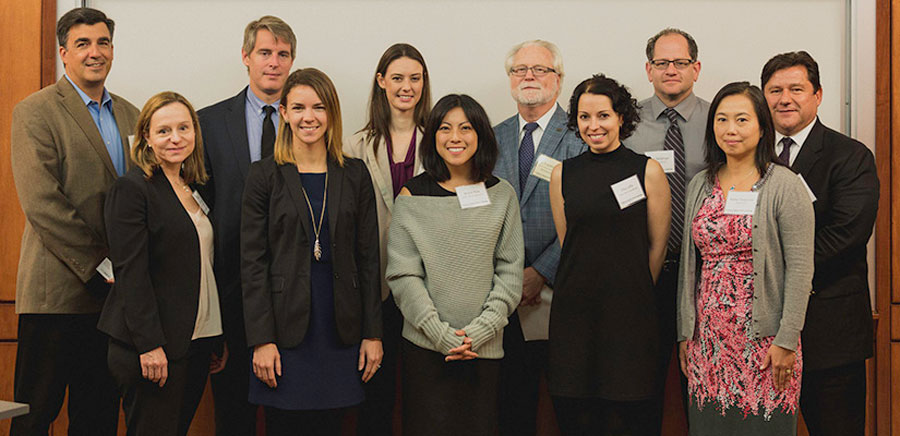Awardees of the 2017 Seventh Annual Pediatric Device Innovation Competition include devices for non-surgical eardrum repair, reducing infant mortality in low resource environments, treatment of amblyopia, low-pressure finger cuff continuous noninvasive monitoring of infant blood pressure, decreasing incidence of unplanned teenage pregnancy, and improving intracranial pressure monitor for hydrocephalus.
The 13 finalists presented their product concepts and development plans September 25, 2017, at Virginia Commonwealth University in Richmond, Virginia. The panel of judges included physicians, surgeons, business professionals and engineering representatives.
Projects were evaluated on their clinical significance; approach to product development; likelihood for marketing success; project team expertise, environment and resources; and potential for additional funding toward FDA clearance and commercialization.
The APDC grant awards will assist winners in further developing their devices toward commercialization. APDC associates will also be available to advise in prototyping, consulting, clinical trial design, regulatory strategies, business development strategies and manufacturing.
2017 year’s winners:
Delivery System Development for a Gel Patch for Nonsurgical Eardrum Repair
PI: Elaine Horn-Ranney, Ph.D. Company: Tympanogen, Inc.
The Device: Perf-Fix™ is a nonsurgical alternative for eardrum repair. The light-curable gel patch acts as a scaffold that allows cells to grow across the perforation. For patients the procedure is less painful than traditional methods, all surgical and anesthesia complications are eliminated, and the quality of regenerated eardrum tissue is improved. For otolaryngologists, the process of performing this procedure is significantly more efficient.
Binocuclear: Binocular Medical Device for the Treatment of Amblyopia (Renewal)
PI: Joseph Koziak Company: Amblyotech Inc.
The Device: Binocuclear is a novel and patented medical device for the treatment of amblyopia, an ocular disorder known as “lazy eye” that develops in infancy or early childhood. The binocular game is pre-loaded into a gaming device (iPad or a similar tablet device) and prescribed by a physician.
Non-Electric, Long Lasting, Infant Warming Technology
PI: Vika Ioffe Company: Warmilu LLC
The Device: The IncuBlanket was designed to improve morbidity and mortality of infants, improve parental bonding, and reduce the costs for any institution caring for premature infants.
The IncuBlanket and its InstaWarmer pack generate a long lasting, completely non-electric, reusable, safe warming solution to provide infant caregivers effective, portable thermoregulation.
CareTaker4 Pediatric
PI: Jeff Pompeo, President & CEO Company: CareTaker Medical Corp.
The Device: CareTaker4 is a simple, low-pressure finger cuff that measures continuous noninvasive (Beat-by-Beat) blood pressure (“cNIBP”), heart rate, and other physiological parameters displayed on a wireless remote monitor. This project will redesign the finger cuff, monitoring algorithms, and form factor to effectively accommodate the size and physiological needs of pediatric patients.
Cadence
PI: Amanda French, BS – Mechanical Engineering Company: Stanford University
The Device: Cadence was designed to decrease the incidence of unplanned teenage pregnancy. Cadence improves oral contraceptive pills (OCP) medication adherence and provides education on contraception and personalized pregnancy risk. The app provides feedback on potential consequences of one’s pill taking behavior by indicating when women are at risk of pregnancy and when they should use backup contraception.
Intracranial Pressure Sensor for Hydrocephalus
PI: Ken Goldman Company: H-Cubed Inc.
The Device: The Intracranial Pressure Sensor is a telemetric pressure sensor to wirelessly monitor intracranial pressure in vivo and detect the onset of shunt failure. This pressure sensor provides patients with a precise diagnosis with minimal discomfort and helps to determine how patients will react to a particular therapy.
The Atlantic Pediatric Device Consortium provides a national platform to translate ideas through the product development pathway all the way to commercialization. With funding from the FDA Office of Orphan Products Development, our mission is to enhance the lives of children through the development of novel pediatric medical devices that are both safe and effective. The Consortium fosters an environment of creativity, where innovative ideas are reviewed, tested and developed by a multidisciplinary team of experts from the Georgia Institute of Technology, Emory University, Virginia Commonwealth University and Children’s Healthcare of Atlanta.
About VCU School of Engineering:
The VCU School of Engineering, an innovation front runner in academics and research, brings real-world education to Central Virginia. Our collaborative and multidisciplinary partnerships prepare undergraduate, master’s and doctoral students for leadership. Part of a premier urban research university, the VCU School of Engineering enhances regional and global prosperity through cutting-edge development in tissue engineering, drug delivery, bioinformatics, cybersecurity, mechanical systems and particle science. We make it real by turning great ideas into breakthrough technologies. Our facilities are hubs of discovery, powered by an expanding student body and faculty committed to excellence. We encourage partnering with industry and the community, bringing new collaborators into our projects. Our key research areas include: sustainability and energy engineering; micro and nano electronic systems; pharmaceutical engineering; mechanobiology and regenerative medicine; big data mining; and device design and development.
